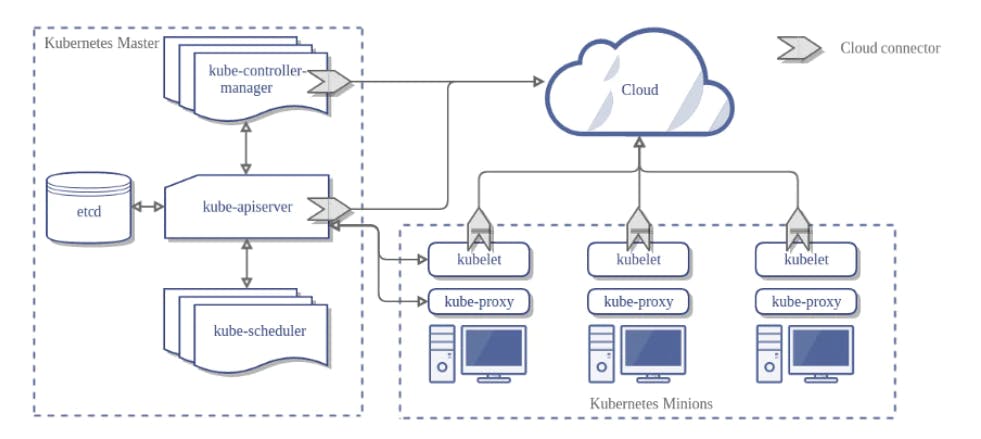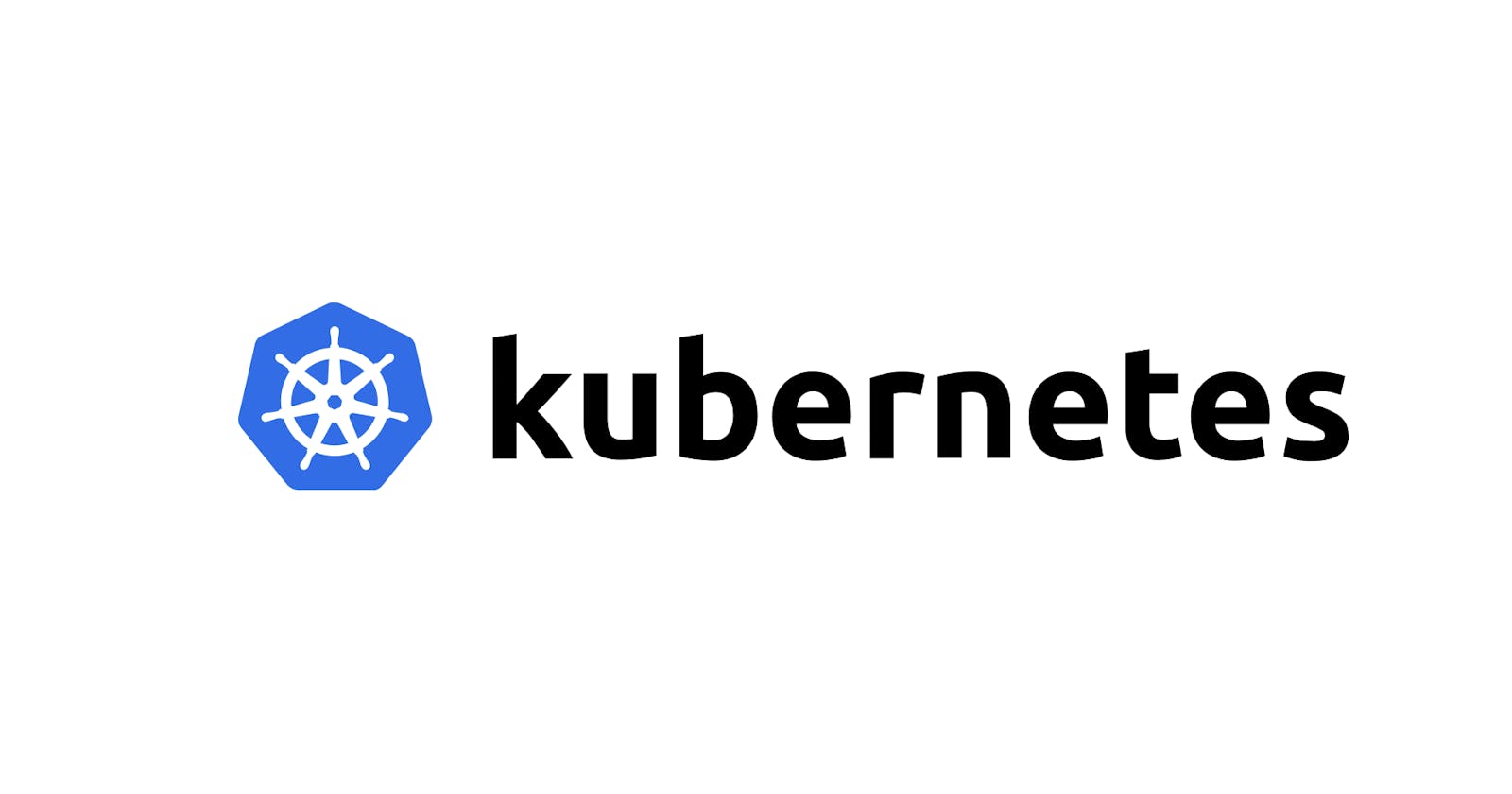There are some basic concepts and terms related to Kubernetes (K8s) that are important to understand before we head into setting up a Kubernetes cluster. This article describes the essential components of Kubernetes that will provide you required knowledge to get started.

Nodes (Minions):
A node is a machine either physical or virtual machine on which Kubernetes is installed. A node is a worker machine and this is where containers inside the pods will be launched by Kubernetes.
Cluster:
If our a node fails, our app will be down. So a cluster is a set of nodes grouped together. Even if one node fails, your application will still be accessible from the other nodes. In addition, having multiple nodes helps in sharing the computational load as well.
A Kubernetes cluster consists of one or more nodes managed by Kubernetes. The nodes are bare-metal servers, on-premises VMs, or VMs on a cloud provider. Every node contains a container runtime (for example a Docker Engine), Kubelet (responsible for starting, stopping, and managing individual containers by requests from the Kubernetes control plane), and kube-proxy (responsible for networking and load balancing).
Master Node:
Who is responsible for managing the cluster? Where is the information about the members of the cluster stored? How are the nodes monitored? When a node fails, how do you move the workload of the failed node to another worker node? — Here comes Master Node
A Kubernetes cluster also contains one or more master nodes that run the Kubernetes control plane. The control plane consists of different processes, such as an API server (provides JSON over HTTP API), scheduler (selects nodes to run containers), controller manager (runs controllers — see below), and etcd (a globally available configuration store).
Pod:
A pod is the smallest deployable unit that can be managed by Kubernetes. A pod is a logical group of one or more containers that share the same IP address and port space. The main purpose of a pod is to support co-located processes, such as an application server and its local cache.
Containers within a pod can find each other via localhost and can also communicate with each other using standard inter-process communications like SystemV, semaphores, or POSIX shared memory. In other words, a pod represents a “logical host”. Pods are not durable; they will not survive scheduling failures or node failures. If a node where the pod is running dies, the pod is deleted. It can then be replaced by an identical pod, with even the same name, but with a new unique identifier (UID).
Note: When you install Kubernetes on a System, you are actually installing the following components: an API Server, an ETCD service, a kubelet service, a Container Runtime, Controllers. and Schedulers.
Master Node Components
- API Server 2. Controller Manager 3. ETCD 4. Scheduler (Not in below pic)

Kube-APIServer:
APIs allow applications to communicate with one another. There is a component on the master that exposes the Kubernetes API. It is the front-end for the Kubernetes control plane. It is designed to scale horizontally — that is, it scales by deploying more instances. The users, management devices, and command line interfaces all talk to the API server to interact with the Kubernetes cluster.
Kube-Scheduler:
It is a component on the master node that watches newly created pods that have no node assigned and selects a node for them to run on.
Factors taken into account for scheduling decisions include individual and collective resource requirements, hardware/software/policy constraints, affinity and anti-affinity specifications, data locality, inter-workload interference, and deadlines.
Kube-Controller-manager:
This is a component on the master that runs controllers.
Logically, each controller is a separate process, but to reduce complexity, they are all compiled into a single binary and run in a single process.
These controllers include:
Node Controller: Responsible for noticing and responding when nodes go down.
Replication Controller: Responsible for maintaining the correct number of pods for every replication controller object in the system.
Endpoints Controller: Populates the Endpoints object (that is, it joins Services and Pods).
Service Account and Token Controllers: Create default accounts and API access tokens for new namespaces.
Cloud-Controller-Manager
Cloud-controller-manager runs controllers that interact with the underlying cloud providers. The cloud-controller-manager binary is an alpha feature introduced in Kubernetes release 1.6. Cloud-controller-manager runs cloud-provider-specific controller loops only. You must disable these controller loops in the Kube-controller-manager. You can disable the controller loops by setting the --cloud-provider flag to external when starting the Kube-controller-manager.
Node Controller: For checking the cloud provider to determine if a node has been deleted in the cloud after it stops responding.
Route Controller: For setting up routes in the underlying cloud infrastructure.
Service Controller: For creating, updating, and deleting cloud provider load balancers.
Volume Controller: For creating, attaching, and mounting volumes, and interacting with the cloud provider to orchestrate volumes.
ETCD:
It stores the configuration information which can be used by each of the nodes in the cluster. It is a high availability key-value store that can be distributed among multiple nodes. It is accessible only by Kubernetes API server as it may have some sensitive information. It is a distributed key-value store which is accessible to all.
ETCD is a distributed reliable key-value store used by Kubernetes to store all data used to manage the cluster. Think of it this way, when you have multiple nodes and multiple masters in your cluster, etcd stores all that information on all the nodes in the cluster in a distributed manner. ETCD is responsible for implementing locks within the cluster to ensure there are no conflicts between the Masters.
Scheduler:
This is one of the key components of Kubernetes master. It is a service in master responsible for distributing the workload or containers across multiple nodes. It is responsible for tracking the utilization of the working load on cluster nodes and then placing the workload on which resources are available and accept the workload. In other words, this is the mechanism responsible for allocating pods to available nodes. The scheduler is responsible for workload utilization and allocating pod to a new node. It looks for newly created containers and assigns them to Nodes.
Kubernetes Node Components
Node components run on every node, maintaining running pods and providing the Kubernetes runtime environment.
Docker:
The first requirement of each node is Docker which helps in running the encapsulated application containers in a relatively isolated but lightweight operating environment.
Container Runtime:
The container runtime is the underlying software that is used to run containers. In our case, it happens to be Docker. The container runtime is the software that is responsible for running containers. Kubernetes supports several runtimes: Docker, containerd, cri-o, rktlet, and any implementation of the Kubernetes CRI (Container Runtime Interface).
Kubelet:
Kubelet is the agent that runs on each node in the cluster. The agent is responsible for making sure that the containers are running on the nodes as expected.
It’s a small service in each node responsible for relaying information to and from control plane service. It interacts with etcd store to read configuration details and write values. This communicates with the master component to receive commands and work. The kubelet process then assumes responsibility for maintaining the state of work and the node server. It manages network rules, port forwarding, etc.
The kubelet takes a set of PodSpecs that are provided through various mechanisms and ensures that the containers described in those PodSpecs are running and healthy. The kubelet doesn’t manage containers which were not created by Kubernetes.
Kubernetes Proxy Service:
This is a proxy service which runs on each node and helps in making services available to the external host. It helps in forwarding the request to correct containers and is capable of performing primitive load balancing. It makes sure that the networking environment is predictable and accessible and at the same time it is isolated as well. It manages pods on node, volumes, secrets, creating new containers’ health checkup, etc.

